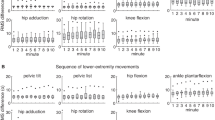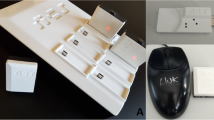Abstract
A novel method of recording intersegmental spine kinematics was developed. The method was required to: (1) have similar accuracy and precision as current methods that record gross spine kinematics; (2) be reasonably insensitive to errors associated with marker detection or misplacement; and (3) be reasonably insensitive to skin movement artefacts. Four healthy participants performed trunk flexion, lateral bending, and axial twist movements; data were collected using the intersegmental method as well as electromagnetic sensors. Comparing methods, gross angular kinematic differences were within 1 SD during flexion and lateral bend, while axial twist resulted in the largest differences. To test sensitivity to marker error, random error was added to marker positions. The most proximal and distal intersegmental units were the most sensitive to marker error. Adding additional markers at the ends or interpolating padded markers reduced this sensitivity. The influence of skin movement artefact was investigated by digitizing locations of the skin with respect to the spinous processes in both neutral and fully flexed postures. In the lumbar region, large skin artefacts had minimal effect on intersegmental angles. The greatest strength of this method is the ability to dynamically record intersegmental spine kinematics.







Similar content being viewed by others
Abbreviations
- AP:
-
Anterior/posterior axis
- AT:
-
Cardan angle about the superior/inferior axis
- C7:
-
7th cervical vertebrae
- FE:
-
Cardan angle about the mediolateral axis
- LB:
-
Cardan angle about the anterior/posterior axis
- LCS:
-
Local coordinate system
- S1:
-
1st sacral vertebrae
- ML:
-
Mediolateral axis
- SI:
-
Superior/inferior axis
- T12:
-
12th thoracic vertebrae
References
Adams, M. A., and W. C. Hutton. Prolapsed intervertebral disc. A hyperflexion injury 1981 Volvo Award in Basic Science. Spine 7(3):184–191, 1982.
Adams, M. A., W. C. Hutton, and J. R. Stott. The resistance to flexion of the lumbar intervertebral joint. Spine 5(3):245–253, 1980.
Ahmadi, A., N. Maroufi, H. Behtash, H. Zekavat, and M. Parnianpour. Kinematic analysis of dynamic lumbar motion in patients with lumbar segmental instability using digital videofluoroscopy. Eur. Spine J. 18(11):1677–1685, 2009.
Beaudette, S., D. P. Zwambag, L. R. Bent, and S. H. M. Brown. Spine postural change elicits localized skin structural deformation of the trunk dorsum in vivo. J. Mech. Behav. Biomed. Mater. 67:31–39, 2017.
Campbell-Kyureghyan, N., M. Jorgensen, D. Burr, and W. Marras. The prediction of lumbar spine geometry: method development and validation. Clin. Biomech. 20(5):455–464, 2005.
Cholewicki, J., and S. M. McGill. Lumbar posterior ligament involvement during extremely heavy lifts estimated from fluoroscopic measurements. J. Biomech. 25(1):17–28, 1992.
Cholewicki, J., and S. M. McGill. Mechanical stability of the in vivo lumbar spine: implications for injury and chronic low back pain. Clin. Biomech. 11(1):1–15, 1996.
Cloud, B. A., K. D. Zhao, R. Breighner, H. Giambini, and K. An. Agreement between fibre optic and optoelectronic systems for quantifying sagittal plane spinal curvature in sitting. Gait Posture. 40(3):369–374, 2014.
Crisco, J. J., and M. M. Panjabi. Euler stability of the human ligamentous lumbar spine. Part I: Theory. Clin. Biomech. 7(1):19–26, 1992.
Crisco, J. J., M. M. Panjabi, I. Yamamoto, and T. R. Oxland. Euler stability of the human ligamentous lumbar spine. Part II: Experiment. Clin. Biomech. 7(1):27–32, 1992.
Farfan, H. F. Mechanical Disorders of the Low Back. Philadelphia: Lea & Febiger, p. 247, 1973.
Granata, K. P., and P. Gottipati. Fatigue influences the dynamic stability of the torso. Ergonomics 51(8):1258–1271, 2008.
Gunning, J. L., J. P. Callaghan, and S. M. McGill. Spinal posture and prior loading history modulate compressive strength and type of failure in the spine: a biomechanical study using a porcine cervical spine model. Clin. Biomech. 16(6):471–480, 2001.
Howarth, S. J. Comparison of two methods of measuring spine angular kinematics during dynamic flexion movements: skin-mounted markers compared with markers affixed to rigid bodies. J. Manip. Physiol. Ther. 37(9):688–695, 2014.
Iatridis, J. C., P. L. Mente, I. A. Stokes, D. D. Aronsson, and M. Alini. Compression-induced changes in intervertebral disc properties in a rat tail model. Spine 24(10):996–1002, 1999.
Jin, S., X. Ning, and G. A. Mirka. An algorithm for defining the onset and cessation of the flexion–relaxation phenomenon in the low back musculature. J. Electromyogr. Kinesiol. 22(3):376–382, 2012.
Mahallati, S., H. Rouhani, R. Preuss, K. Masani, and M. R. Popovic. Multisegment kinematics of the spinal column: soft tissue artifacts assessment. J. Biomech. Eng. 138(7):1–8, 2016.
McGill, S. M., and J. Cholewicki. Biomechanical basis for stability: an explanation to enhance clinical utility. J. Orthop. Sports Phys. Ther. 31(2):96–100, 2001.
McGill, S. M., and V. Kippers. Transfer of loads between lumbar tissues during the flexion–relaxation phenomenon. Spine 19(19):2190–2196, 1994.
Mok, N. W., S. G. Brauer, and P. W. Hodges. Changes in lumbar movement in people with low back pain are related to compromised balance. Spine 36(1):E45–E52, 2011.
Morris, J. M., D. B. Lucas, and B. Bresler. Role of the trunk in stability of the spine. J. Bone Jt. Surg. Am. 43(4):327–351, 1961.
Nelson, J. M., R. P. Walmsley, and J. M. Stevenson. Relative lumbar and pelvic motion during loaded spinal flexion/extension. Spine 20(2):199–204, 1995.
Panjabi, M. M. The stabilizing system of the spine. Part 1. Function, dysfunction, adaption, and enhancement. J. Spinal Dis. 5(4):383–389, 1992.
Panjabi, M. M., K. Abumi, J. Duranceau, and T. Oxland. Spinal stability and intersegment muscle forces. A biomechanical model. Spine 14(2):194–200, 1989.
Pearcy, M. J., and R. J. Hindle. New method for the non-invasive three-dimensional measurement of human back movement. Clin. Biomech. 4(1):73–79, 1989.
Preuss, R., and J. Fung. Can acute low back pain result from segmental spinal buckling during submaximal activities? A review of the literature. Manual Ther. 10(1):14–20, 2005.
Preuss, R., and M. R. Popovic. Three-dimensional spine kinematics during multidirectional, target-directed trunk movement in sitting. J. Electromyogr. Kinesiol. 20(5):823–832, 2010.
Ross, G. B., P. J. Sheahan, B. Mahoney, B. J. Gurd, P. W. Hodges, and R. B. Graham. Pain catastrophizing moderates changes in spinal control in response to noxiously induced low back pain. J. Biomech. 58:64–70, 2017.
Saifuddin, A., S. Blease, and E. MacSweeney. Axial loaded MRI of the lumbar spine. Clin. Radiol. 58(9):661–671, 2003.
Schinkel-Ivy, A., and J. D. M. Drake. Which motion segments are required to sufficiently characterize the kinematic behaviour of the trunk? J. Electromyogr. Kinesiol. 25(2):239–246, 2015.
Shin, G., and G. A. Mirka. An in vivo assessment of the low back response to prolonged flexion: interplay between active and passive tissues. Clin. Biomech. 22(9):965–971, 2007.
Shin, J., S. Wang, Q. Yao, K. B. Wood, and G. Li. Investigation of coupled bending of the lumbar spine during dynamic axial rotation of the body. Eur. Spine J. 22(12):2671–2677, 2013.
Sullivan, M. S., C. E. Dickinson, and J. D. Troup. The influence of age and gender on lumbar spine sagittal plane range of motion. A study of 1126 healthy subjects. Spine 19(6):682–686, 1994.
Swinkels, A., and P. Dolan. Regional assessment of joint position in the spine. Spine 23(5):590–597, 1998.
Teyhen, D. S., T. W. Flynn, J. D. Childs, T. R. Kuklo, M. K. Rosner, D. W. Polly, and L. D. Abraham. Fluoroscopic video to identify aberrant lumbar motion. Spine 32(7):E220–E229, 2007.
Yingling, V. R., J. P. Callaghan, and S. M. McGill. Dynamic loading affects the mechanical properties and failure site of porcine spines. Clin. Biomech. 12(5):301–305, 1997.
Zemp, R., R. List, T. Gülay, J. P. Elsig, J. Naxera, W. R. Taylor, and S. Lorensetti. Soft tissue artefacts of the human back: comparison of sagittal curvature of the spine measured using skin markers and an open upright MRI. PLoS ONE 9(4):e95426, 2014.
Acknowledgments
The authors would like to acknowledge the Natural Sciences and Engineering Research Council (NSERC) of Canada for funding.
Author information
Authors and Affiliations
Corresponding author
Additional information
Associate Editor Dan Elson oversaw the review of this article.
Rights and permissions
About this article
Cite this article
Zwambag, D.P., Beaudette, S.M., Gregory, D.E. et al. Development of a Novel Technique to Record 3D Intersegmental Angular Kinematics During Dynamic Spine Movements. Ann Biomed Eng 46, 298–309 (2018). https://doi.org/10.1007/s10439-017-1970-x
Received:
Accepted:
Published:
Issue Date:
DOI: https://doi.org/10.1007/s10439-017-1970-x




